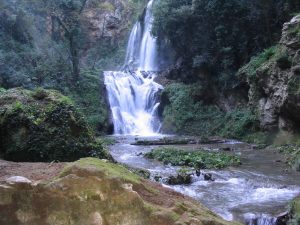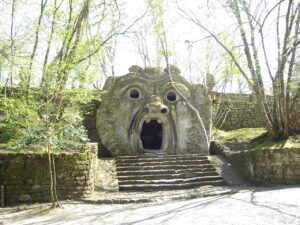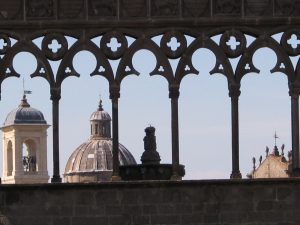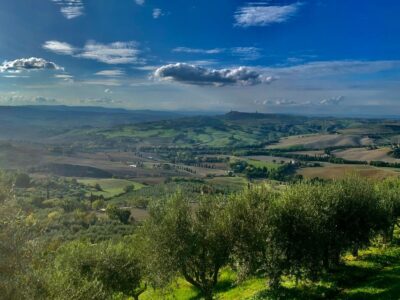Visit with us the region of Rome and its beautiful towns and coast of the Tyrrhenian Sea. A central Italy region to be discovered beside Rome and Vatican. Several unusual places and towns to see. We offers guided tours, travel packages in this italian region.
Lazio is the region where the magnificent and unique city of Rome is located, for this reason many other areas around are still to be discovered by visitors. This region offers a very wide range of historical and natural attractions, both in the north and tin the south part. Several interesting locations such as the Bolsena Lake the village of Civita di Bagnoregio, Bomarzo and Viterbo, with its spa and its medieval quarter and again Sperlonga, Gaeta, Tivoli.
 This region is becoming more and more popular as well as Umbria and Tuscany, and today offers high quality standards concerning tourism and vacations, starting from the sea cost and the several historic towns, until the unique and charming Rome. Especially Northern Lazio, with the wide Viterbo province, has more and more developed a genuine quality standard. Far from the crowded Rome and from its traffic, Bolsena, Acquapendente, Montefiascone and Bagnoregio are relaxing and beautiful “shelters”. Although, we must remember that the Tuscia area, because of its nearness to the Umbria and Tuscany borders, is perfect for art and history lovers. The whole area is rich of wonderful boroughs and towns to discover, around which are many nice villas and country houses to satisfy the visitors’ needs.
This region is becoming more and more popular as well as Umbria and Tuscany, and today offers high quality standards concerning tourism and vacations, starting from the sea cost and the several historic towns, until the unique and charming Rome. Especially Northern Lazio, with the wide Viterbo province, has more and more developed a genuine quality standard. Far from the crowded Rome and from its traffic, Bolsena, Acquapendente, Montefiascone and Bagnoregio are relaxing and beautiful “shelters”. Although, we must remember that the Tuscia area, because of its nearness to the Umbria and Tuscany borders, is perfect for art and history lovers. The whole area is rich of wonderful boroughs and towns to discover, around which are many nice villas and country houses to satisfy the visitors’ needs.
Moreover, also the unspoiled area south of Rome is beautifuland worth a visit: the Circeo National Park, Sperlonga, Sabaudia, Gaeta, Anzio are appreciated seaside locations. Many amazing towns and attractions are also near Rome, among these places: Tivoli with Villa d’Este, Villa Gregoriana and the archaeological park of Villa Adriana (Unesco site). Because of the great Roman tradition and love for spas, in the region of Lazio you can find several baths and spas, like Viterbo (Terme dei Papi), Fiuggi, Tivoli terme.

This region mainly has a hill countryside, with an average altitude of 300-350 mts. The Tyrrenium coast is flat, the area around Rome offers several hills, while west bound you can find high mountains, such as Monti Carseolani, Simbruini, Ernici, della Meta. Some of them are higher than 2,000 mts (Monte Cornacchia, Monte Viglio, Monte la Meta, Monte Terminillo). The main rivers in Lazio are the Tiber, that runs through Rome, Sacco, Liri and Aniene. The Aniene supplies water to the spectacular fountains in Villa d’Este in Tivoli and makes the impressive water falls at Villa Gregoriana. There are also several lakes in the region: the main lakes are Bolsena and Bracciano (ideal locations for lake journey lovers), other smaller lakes: Vico, Turano, Salto, Albano, Fogliano, Canterno and Mezzano.
The most important natural parks are the Circeo National Park (south of Rome), the Abruzzo National park (next to the western border), the Natural Archaeological park of Vulci (near Tuscany), the Park of Veio, Selva di Lamone (in the Viterbo province) and many other parks – gardens, such as the beautiful Giardino della Landriana around Rome, or the Oasi di Ninfa, south Rome.
Lazio cuisine, especially the one from Rome, has very ancient origins, some Etruscans, some Romans, some even Jews, such as corata di agnello. Other meat dishes are coda alla Vaccinara, the famous Porchetta (from Ariccia) and many kinds of pasta, like the famous Amatriciana and Carbonara. There are also many other specialties, like lentils, vegetables, or fish and sea food along the coast.. For what concerns cakes and dessert, the most important are dry fruit cakes and jams. One of the best wines in this region is the white from the Castelli romani and from Capena. Artisans in Lazio basically work in the textile, iron, marbles and travertino stone fields. The main artistic events often happen in Rome, like concerts, theatrical shows and any kind of show.

Moreover Rome is not only past but present, too: so there are many squares and avenues where it is easy to find typical Italian shops, restaurants, museums and other amazing places. In the surrounding area there are several typical towns, not far you can find Tivoli with its thermal baths and the wonderful Roman buildings of Villa Adriana and Villa d’Este. If you are interesting in nature, a visit to the Landriana Gardens is a must.
LAZIO COAST – this area holds many interesting places ideal both for a sea tourism and for a cultural tourism. In fact in this area you can find important history zones like Ostia, Tarquinia and the Vulci Park with Roman and Etruscan ruins and museums. This land presents calm and relaxing landscapes and several small typical boroughs. Taking the Aurelia motorway and going north along the coast you can easily reach the Tuscany lowlands and the Maremma areas, while going south you can discover the marvelous area of the Circeo National Park and many other special places, like Sperlonga, Sabaudia up to the Pontine islands.
LAZIO – SOUTHERN ROME – This area is characterized by wide plains, country scenarios such as the Ciociaria land, long beaches, mountains. The most important cities are Latina and Frosinone, located southern Rome. We suggest the following place to visit: Montecassino Abbey. It was founded by Saint Benedetto in 529 on a previous Roman fortress, called Casinum. Near the monastry, there is a rich museum with many Roman and Etruscan ruins and discovers.
Not far from Sora, another beautiful town, there is an interesting abbey, called the Casamari Abbey.
Among the many interesting boroughs, we suggest Alvito, with its Palazzo Ducale, Cassino, Monte San Giovanni Campano, with its castle, the Medieval borough of San Donato Val di Comino and Fiuggi, with its World wide famous Spa and water sources. Soon after the border which separates Latina and Frosinone provinces, is located Pastena, a castle restored in 1227 under the domain of Del Drago family. In this area are located the famous Caves Grotte di Pastena.

OSTIA – this big town is modern has a typical fascist architecture. The most important part to visit is the coast. Also the Ancient Ostia is worth a visit, where is located one of the best Roman sites. Many Roman domus and public forum are still visible, as well as the Claudio Harbor and the exagonal Traiano harbor.
CIVITAVECCHIA – Important harbor in Italy, Civitavecchia is also a town rich of history and places to see: Forte Michelangelo, Roman Darsena, Antico Lazzaretto, and in town, the Cathedral, the Archaeological Museum. Not far from the town are the old Terme Taurine, an ancient spa made by the Roman emperor Traiano, which is still greatly kept and visible. For those who love summer amusements, we suggest the Acquafelix. For those who love trekking and hiking, we suggest the Monti della Tolfa Natural Park.
The “Tuscia Area”
BOLSENA – This town gives its name to the close lake and it is sited on one side of the Volsinii Hills.
Bolsena has Etruscan origins and it preserves every further historical age trace. This was the area where the Romans, after conquering the close Orvieto (Velzna), moved all of the prisoners which built the new Orvieto (Novi Velzna). Its castle dominates the surrounding boroughs from the top and it was recently restored. Today it hosts an interesting Lake Territorial Museum. Bolsena Lake has been declared the cleanest lake in Europe. Its basin and its endowed lake front allow the tourists to spend cultural and joyful holidays.
Starting from Bolsena and wandering through the panoramic street around the lake, you can come across many colorful towns: Montefiascone, with its stunning lake panorama, Marta, a fishermen’s town, Capodimonte, Valentano, Gradoli, Grotte di Castro, a beautiful Medieval borough and San Lorenzo Nuovo, a perfect example of Eighteenth Century urban settlement (a rare eight sided square is the town center).

BOMARZO – Deeply plunged in the Viterbo district and in a particularly green area, Bomarzo is a real representation of a perfectly maintained Medieval town. Its unique Rocky Monster’s Park is a great half a day stop. The name “Bomarzo” is supposed to come from the Roman period from the word Polymartium, of uncertain meaning. It was a property of the Orsini family, whose castle is at the edge of the densely-built town, until Marzio sold it to the Lante family in 1645. Bomarzo’s main attraction is a garden usually referred to as the Bosco Sacro (Sacred grove) or, locally, Bosco dei Mostri (“Monsters’ Grove”), because of its several large stone sculptures which populate this particular landscape. A sphinx is located right at the entrance of the Park of the Monsters.
This garden was made by Pier Francesco Orsini, called Vicino (1528–1588), the patron of the arts, greatly devoted to his wife Giulia Farnese; when she died, he created the gardens for her.
The park of Bomarzo was meant not to please, but to shock visitors. In itself there are lots of arcane symbolism. The reason for the layout and design of the garden is largely unknown: perhaps it was meant as a foil to the perfect symmetry and layout of the great Renaissance gardens, in the near Villa Farnese and Villa Lante. Next to a formal exedra is a tilting watchtower , the so-called Casa Storta (“Hanging House”).
An octagonal temple was added about twenty years later to honor the second wife of Orsini, Giulia Farnese.
During the Nineteenth Century and deep into the Twentieth Century, the garden became overgrown and neglected, but in the 1970s a restoration program was implemented by the Bettini family, and today the garden, which remains a private property, is a major tourist attraction. The surreal nature of the Parco dei Mostri appealed to Jean Cocteau and the great surrealist Salvador Dalí, who discussed it at great length. The poet André Pieyre de Mandiargues wrote an essay devoted to Bomarzo. Niki de Saint Phalle was inspired by Bomarzo for her Tarot Garden. The story behind Bomarzo and the life of Pier Francesco Orsini are the subject of a fascinating novel by the Argentinian writer Manuel Mujica Láinez (1910-1984), Bomarzo (1962). Mujica Láinez himself wrote a libretto based on his novel, which was set to music by Alberto Ginastera (1967). The opera Bomarzo premiered in Washington in 1967. In Argentina the opera was banned by the military dictatorship, but in the USA both Mujica Láinez and Ginastera were awarded with the Pulitzer Prize.
ACQUAPENDENTE – There are not sure details about Acquapendente origins. Though, the best hypothesis is about Etruscan origins, later conquered by the Romans and finally destroyed by the Lungobards. Acquapendente is very close to Tuscany (3 km from Siena’s district), and close to Umbria, too. Gracious and charming, this town puts together both beautiful architectural and natural features, such as the Duomo and the Rufeno Mountain. Mount Rufeno Park has become a natural reserve and it has been expanded in a wide area of 3000 acres. Within its territory many animal species can be discovered, starting from foxes, wild boars, hares, squirrels, dormice, barn-owls, porcupines and deer. This is why it is correct to consider Monte Rufeno kind of a nature lovers paradise. Not far from this town there is the nice borugh of Torre Alfina, with its great castle, which is a marvellous example of Medieval art.

VITERBO – This is one of the Pope’s cities, rich of historical elements as churches, castles, towers, ruins and an authentic jewel: the San Pellegrino quarter. The historical downtown, surrounded by Eleventh century city walls, encloses several monuments. Since the Etruscans, the city has always been considered central and strategic, especially during Gregorio X’s pontificate. Evidence of the religious heritage is the magnificent Palazzo Papale, sited in the heart of the Medieval quarter. Driving around Viterbo, it is very easy to discover hidden attractions, starting from the Roman age (Ferento’s Roman Amphitheatre), crossing through the important Renaissance Palazzo Farnese in Caprarola, ending to the amazing Villa Lante sited in Bagnaia. Villa Lante is a perfect example of an Italian Sixteenth Century villa with garden, surrounded by thick walls and full of original monuments. Its garden is the result of centuries of tradition. Another great Italian monument is the close Castello Ruspoli in Vignanello. And just in the neighborhood of Viterbo you can find the Vico Lake and the archaeological sites of Ferento and Sutri. Not far there is the Bracciano Lake with the Aviation Museum of Vigna di Valle.
CAPRAROLA – Palazzo Farnese – Few steps far from the Medieval city of Viterbo, the proud ang glorious Villa Farnese has been standing for more than 500 years. The building complex dominates the whole area, with the delicious Caprarola town. The beautiful Farnese family residence was built by Antonio da Sangallo, to be a defensive fortress but in 1559, because of the will of Cardinal Alessandro Farnese, the building was transformed into a great Reinassance palace. Absolutely to visit !
CIVITA DI BAGNOREGIO – Civita di Bagnoregio may be considered a true open-air museum. It is a pleasure to walk through its picturesque streets and ancient buildings. Don’t miss the Church of San Donato in the main square and the Museo Geologico e delle Frane (Geology Museum). Civita is a perfect place for a quiet, charming walk also enjoying the beautiful panorama of the valley of gullies that opens all around the village. The village has been replicated and used as a film set, including Pinocchio. Main monuments: Porta Albana (1589), S. Bonaventura Church (1632), S. Nicola Church (1581), where you can admire an antique Roman sarcofag used as an altar.
TUSCANIA – Tuscania is a typical Etruscan town, with its traditional red volcanic colors and ancient Roman monuments. This town is a few km far from Viterbo, and also near the Umbrian border. An Etruscan presence is dominant here: necropolis here collect important treasures, some of which can be admired at the local Archaeological Museum. San Pietro Cathedral: this beautiful church is considered the main one in town, and it keeps the origianl Twelveth Century design. The facade is typically Romanic. Particular attention is due to the indoors and to the underground rooms. Downstairs, in fact, you can visit the beautiful Columns room, a refined room where each column has been made in a different style.
Castiglione in Teverina – Beautiful Medieval borough, famous for its incredible “Piazzetta”, where every year an important Wine Festival takes place. You can reach it by walking through narrow streets among Sixteenth Century buildings. Important monuments: SS. Filippo and Giacomo Church and the Wine Museum (the biggest in Europe).
Celleno – Main monuments: S. Giovanni Battista Convent and Orsini Castle, with its small S. Carlo Church. Celleno borough is very small but intense to live and it offers strong feelings to its visitors any time of the year.
Graffignano – Main monuments: Baglioni Castle and Madonna del Castellonchio Church. In Viterbo county, this town represents a typical north Latium area.
Lubriano – Main monuments: S. Caterina Tower, Bourbon del Monte Palace and a spectacular Monaldeschi Tower. Lubriano is also very close to Bagnoregio and Orvieto, almost on the regional border which divides Umbria and Lazio.

